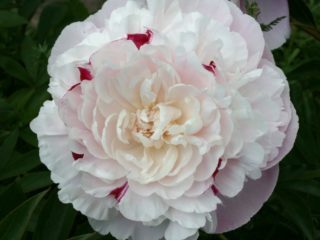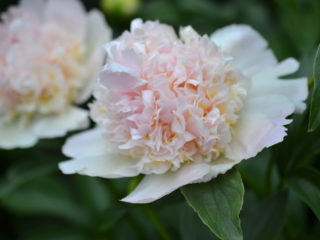Content
Peony Diana Parks is a variety of stunning beauty with a long history. Like most varietal peonies, it is unpretentious and can be cultivated even by inexperienced gardeners. With a little effort, your garden plot will simply “blaze” with bright red inflorescences with an intoxicatingly sweet aroma.
Description of peony Diana Parks
Russian gardeners have long appreciated the Diana Parks hybrid for its diversity and simple agricultural technology. Peonies of this species are a moderately growing herbaceous perennial. A distinctive feature is the densely double inflorescences of scarlet color, reaching a diameter of 13-15 cm.

Peony Diana Parks was developed in the USA in 1942
The stem of the plant is dense, withstands any signs of bad weather (heavy rain, wind) and does not require the installation of supporting supports. The leaf blades of peonies are elongated, with a solid edge and a glossy surface of light green color. Bush height – 60-90 cm.
Like all peonies, "Diana Parks" can grow in the shade, however, it shows better development in sunny areas. This hybrid is classified as an early variety. The first blossoming buds of a fiery scarlet color can be seen already at the end of May - in June.
Peonies "Diana Parks" are actively used by landscape designers.Red flowers are very harmonious both in a single solution and in group plantings. The variety is loved by florists who use scarlet peonies to create voluminous flower arrangements.
The hybrid has good adaptive qualities and can adapt to the climate of the place where it grows. Frost resistance of peony is high (up to -40 ° C). “Diana Parks” does not require shelter for the winter, as it winters well under snow cover.
The peony growing region is the European part of Russia, Transbaikalia. This variety can be found in Western and Eastern Siberia.
Features of flowering
One of the most attractive features of the Diana Parks peony is its flowers. The spherical, densely double inflorescences reach a diameter of 14-15 cm. The color of the flowers is deep red with a delicate orange tint. Petals of "Diana Parks" sparkle in sunlight.
The start date of flowering depends on the region. In the southern regions, the peony begins to bloom on May 25-27, in northern latitudes - from June 5. The flowering period is from 15 to 20 days.
Peonies "Diana Parks" are good both for cutting and as a bright accent on a personal plot. The flowers, in addition to their spectacular appearance, have a soft, richly sweet aroma.

The variety is not afraid of low temperatures and grows well in dry places
The following factors are responsible for the splendor of peony inflorescences:
- planting depth;
- lighting in the selected area;
- properly organized feeding;
- plant age.
Timely pruning of faded buds is important, but watering is not critical, since the hybrid is a drought-resistant species.
Application in design
Peony flowers have a rich hue and can become the dominant chord, both in the flower garden and in the flower bed. To pair with them, it is better to choose calmer plants that play well as a background.
In the flower garden, organic partners for Diana Parks peonies will be:
- purple irises;
- asters;
- lilac phlox;
- small chrysanthemums of white or lavender hue.
When planting peonies on the site, you can accompany them with sunny tansy, primrose, low-growing hostas and conifers.
Flowers of a scarlet hue look great in a flowerbed, on a long discount, multi-tiered flower garden and in single plantings.

The variety is organic and in the form of single bushes
Once the peonies have finished blooming against their bright light green foliage, late-blooming chrysanthemums, zinnias, daylilies, petunias, phlox and lilies will look wonderful.
Reproduction methods
Peonies "Diana Parks" are propagated in two ways: vegetatively and by seeds. The latter method is applicable to wild plants. Cultivated species of peonies are most often propagated by dividing the rhizomes.
To implement this method, select a plant at least 3-4 years old with a well-developed bark system. The separation procedure itself is carried out from mid-August to the first ten days of September. The peony rhizome is divided so that on each “division” there are 2-3 healthy buds and roots at least 12-15 cm long.

The mother root is divided into “divisions” with healthy buds and roots
The finished part is disinfected in a solution of potassium permanganate, after which it is “powdered” with crushed coal or wood ash.
Landing rules
"Diana Parks" peonies can be planted in autumn and spring.But most gardeners choose the autumn period.
The Diana Parks variety prefers well-lit areas, where it demonstrates both vigor and flowering. It grows well in partial shade.
The hybrid does not tolerate dense soil well, preferring moderately moist loamy soil with weak oxidation rates. A prerequisite is deep groundwater (1.5 m from the surface). Too clayey soil is diluted with sand, and from 200 to 400 g of lime is added to soil with a high acidity level.
In about 3-4 weeks, preparations for the planting process begin. To begin with, a planting hole measuring 60×60×60 is formed, after which ⅔ of it is filled with fertile soil, consisting of a mixture of garden soil, humus, sand and peat.
Superphosphate (250 g) and wood ash (1 l) are added on top, after which they are covered with the remaining soil. The bottom is pre-drained using crushed stone, broken slate or brick.
The procedure for planting a “delenka” is simple. The root is placed in the hole and covered with soil, while the buds should be 4-5 cm below the soil level. Too much deepening has a bad effect on the splendor of flowering. The last stage is watering and mulching.

The root is placed in a previously prepared hole and covered with soil.
Aftercare
The main care for the herbaceous peony Diana Parks is watering, fertilizing and mulching. The variety is classified as a drought-resistant variety, so it does not require frequent watering. It is enough that the soil is always moderately moist.
Watering is done under the bush.Average consumption is 2-3 buckets per 1 plant. Before the watering procedure, the soil in the root area is loosened.

In spring, mineral complexes are applied directly under the bush
In the first years of a peony's life, foliar feeding is used. Spraying with Ideal is popular. As soon as the above-ground part sprouts, the bush is sprayed with a urea solution (50 g per 10 liters of water).
If we talk about root types of fertilizers, then in the spring (in March) mineral complexes are scattered “in the snow” under the bush, which are absorbed into the soil along with the melted snow. In May, they are fertilized with a potassium-phosphate mixture and the same complex is used 2 weeks after the end of flowering of the variety.
Preparing for winter
Since the variety is classified as a frost-resistant species, it does not require shelter in winter. A little mulching is sufficient in northern regions.
The following is used as mulch:
- agrofibre;
- conifers;
- straw;
- peat;
- humus.
Pests and diseases
Despite good immunity, the Diana Parks peony is sometimes affected by viruses, and more often by fungal diseases.
Peony diseases:
- Rust - one of the fungal diseases, manifested in the form of brown spots - pads with fungal spores. The affected leaves are removed, and spraying with 1% Bordeaux mixture is used as a preventative measure.
- Gray rot - the most dangerous lesion, affecting all parts of the plant: from leaves to flowers. It appears as a gray coating or brown spots in the root collar area. All affected areas are removed, and the bush is watered with a 0.6% suspension of the drug “Thiram”.
- Powdery mildew - a disease of adult plants. It is easily identified by its characteristic gray-white coating. The method of control is treatment with a 0.5% solution of soda ash or a 0.2% solution of the drug “Figon”.
- The most dangerous pests of the Diana Parks peony are ants that carry aphids. The latter devours the green mass, additionally drawing out all the juices from the plant. The best way to get rid of it is to treat flowers and leaves with Fitoverm or Actellik.
- Bronze beetle dangerous for flowers, as it feeds mainly on petals. The insect is collected by hand or the flowers are sprayed with an infusion of tomato tops.
- Root-knot nematodes affects the roots of the bush. It is impossible to completely eliminate them, so the infected plant is destroyed.
Conclusion
Peony Diana Parks is an amazingly bright, spectacular and beautiful variety that can become a real “star” of a personal plot or flower garden. It is easy to care for, so it can be cultivated even by beginners.
Reviews of peony Diana Parks
The variety "Diana Parks" has collected a whole bunch of positive reviews.














